Multi-dimensional Impact Analysis of Green Supply Chain on sweeteners Costs
The impact of green supply chain on sweetener costs is reflected in multiple dimensions, such as cost composition, driving factors and risk control, by integrating environmental protection concepts and supply chain links. Its core logic lies in the selection of raw materials, optimization of production processes, logistics upgrading and other means to achieve environmental benefits while dynamically adjusting the cost structure.
The direct impact of green supply chain cost structure on sweetener cost.
Raw material cost fluctuation and green selection
Sweetener production relies on agricultural raw materials such as corn and cane sugar, and the green supply chain requires the selection of green raw materials (such as organically grown corn) that comply with environmental standards, which may lead to an increase in procurement costs. However, in the long term, cost efficiency can be optimized through strategies such as centralized purchasing and collaborative supplier management.1 For example, high-fold sweeteners produced by biofermentation (e.g., erythritol) that use renewable energy-driven processing of raw materials can have higher initial costs, but policy subsidies (e.g., green purchasing subsidies) can partially offset the incremental costs.
Green Technology Inputs to the Production Process
The application of green production technologies (e.g., energy-efficient fermentation equipment, cleaner production processes) requires an upfront investment in equipment, but can reduce energy consumption and waste disposal costs. In the case of a sweetener company, for example, replacing the traditional crystallization process with membrane separation technology can reduce water consumption by more than 30% and long-term operating costs by about 15%.1 In addition, energy-saving and emission-reduction measures in the production process (e.g., waste heat recovery, by-product resourcing) can further hedge the cost of technology inputs.
Double effect of logistics and waste disposal costs.
Green logistics (e.g., electric truck transportation, biodegradable packaging) will increase short-term inputs, but through the optimization of transportation routes, co-distribution and other strategies can reduce the unit logistics costs.1 In terms of waste treatment, if the fermentation residue in the production of sweeteners is converted into feed or organic fertilizers through the use of resource technology, the treatment costs can be converted into a secondary income, forming a “cost-benefit” closed loop. "Closed loop.
Conclusion: Green Supply Chain's Long-Term Value Remodeling of Sweetener Costs
The impact of green supply chain on sweetener costs is not simply “increasing” or “decreasing”, but rather exchanging short-term investment for long-term competitiveness. Enterprises need to balance policy compliance, market demand and technological investment, and turn environmental costs into brand premiums and efficiency dividends through supply chain optimization, technological innovation and collaboration. In the future, with the refinement of carbon footprint accounting and intelligent management, the green supply chain will become the core engine of sweetener enterprises to reduce costs and increase efficiency.

To realize green supply chain management in the sweeteners industry, it is necessary to carry out low-carbon, recycling and sustainable transformation of the whole chain from raw material procurement, production process, logistics and transportation, waste treatment to end consumption. The following are the specific implementation paths and key points:
Upstream: green raw material procurement and supplier management
Sustainable agricultural practices
Prioritize the procurement of raw materials from sustainable cultivation (e.g. stevia, corn starch, etc.), and require suppliers to provide organic certification or proof of low-carbon cultivation (e.g. reducing the use of pesticides/fertilizers and protecting biodiversity).
Promote the “contract farming” model by signing long-term agreements with farmers and providing technical training to optimize farming efficiency and reduce environmental footprint.
Supplier Assessment and Collaboration
Establish a supplier ESG (Environmental, Social and Governance) scoring system, and incorporate carbon emissions, water utilization and other indicators into procurement criteria.
For highly polluting segments (e.g., precursor production of chemically synthesized sweeteners), require suppliers to adopt clean technologies (e.g., enzyme-catalyzed replacement of traditional chemical synthesis).
Second, production links: clean technology and resource recycling
Low-carbon production processes
Adopt green technologies such as bio-fermentation and membrane separation to replace energy-intensive processes (e.g. traditional chemical synthesis of aspartame).
Promote waste heat recovery and solar/biomass energy to replace fossil energy to achieve carbon neutral target in the production chain.
Water and Waste Management
Establish closed-loop water treatment system to reduce wastewater discharge; anaerobic fermentation of highly concentrated organic wastewater to produce biogas.
By-product resource utilization (e.g. plant residues from stevioside production are used for organic fertilizer or biofuel).
III. Logistics and Packaging: Reduction and Decarbonization
Green Transportation Network
Optimize logistics routes, giving preference to rail or sea transport as an alternative to road transport; pilot hydrogen or electric trucks for short-distance distribution.
Establish regionalized storage centers to reduce the need for long-distance transportation.
Environmentally friendly packaging design
Use biodegradable materials (e.g. PLA) or lightweight packaging; promote the “large packaging + consumer packaging” model to reduce the use of plastic.
Cooperate with downstream customers to establish a packaging recycling system (e.g. deposit return system).
Downstream Cooperation and Consumer Education
Customer Collaboration for Carbon Reduction
Provide low-carbon sweetener solutions for food and beverage customers, helping them optimize their formulations to reduce usage (e.g., sucralose's high sweetness characteristics can reduce transportation energy consumption).
Enhance supply chain transparency by tracing the carbon footprint of products through blockchain technology.
Consumer guidance
Enhance the price premium of environmentally friendly products by labeling them with “green sweetener” certifications (e.g. Carbon Trust certification).
Conduct popularization campaigns to correct the cognitive bias that natural sweeteners must be more environmentally friendly than synthetics (with full life cycle assessment data).
V. Digitalization and Policy Synergy
Technology Enablement
Use IoT to monitor energy consumption data of each link in the supply chain and optimize resource scheduling through AI.
Develop LCA (Life Cycle Assessment) tools to quantify the environmental impact of different sweeteners and guide decision-making.
Policy and Industry Standards
Actively participate in the development of green standards for the sweetener industry (e.g. ISO 14067 carbon footprint standard).
Seek government subsidies or tax incentives to support green technology R&D (e.g. cell culture method for sweetener production).

Overview of thickeners principles of thickeners
Thickeners are a class of substances that can increase the viscosity of a material system or form a gel, and their thickening principle mainly involves molecular structure and interactions, changes in the rheological properties of the solution, etc. There are differences in the principles of different types of thickeners, which are widely used in a variety of fields, such as food, paints, coatings, and so on.
The core thickening mechanism of thickeners
Formation of macromolecular network structure: thickeners in solution will form macromolecular network structure, these macromolecular networks can lock a large amount of liquid, so that the viscosity of the solution increases.
Change the rheological properties of the solution: the thickener can change the rheological properties of the solution, so that the solution from a Newtonian fluid into a non-Newtonian fluid, that is, under the action of shear, the viscosity of the solution will be reduced with the increase in shear, but in the static or low-shear conditions, the viscosity of the solution will be relatively high.
Intermolecular interactions: thickeners will interact with each other to form aggregates or aggregates, which can increase the viscosity of the solution.
The effect of electrolytes: some thickeners need to add electrolytes in the process of use, such as inorganic salts, the presence of these electrolytes can affect the thickening effect of the thickener.
The specific thickening principle of different types of thickeners
Natural gum thickeners: such as polypolysaccharide, etc. is through the polypolysaccharide sugar unit contains 3 hydroxyl groups and water molecules interact to form a three-dimensional hydration network structure, so as to achieve the effect of thickening.
Cellulose thickeners: mainly through the hydrophobic main chain and the nearby water molecules through hydrogen bonding, thus increasing the space of free movement between the particles to Increase viscosity. At the same time can also be entangled around the molecular chain to achieve the viscosity of the role, this is because in the static or low shear rate, cellulose is mainly in a disordered state; and in high shear rate, the molecules parallel to the activities of the bias was ordered in the shape of the fabric, so the viscosity of the system to land.
Polyacrylic acid thickeners: mainly thickeners dissolved in water, this kind of thickeners then through the carboxylate ions of the same sex electrostatic repulsion, molecular chain from the beginning of the helical development of the rod, increase the viscosity between the water phase, but also through the formation of a mesh layout of the emulsion particles and pigments to increase the viscosity.
Conjugated polyurethane thickener: the molecular layout of this type of thickener is the introduction of hydrophilic groups and hydrophobic groups, when the concentration of the aqueous solution across a particular concentration, it will form micelles, micelles and polymer particles into a mesh layout, thus making the system viscosity growth.
Inorganic thickeners: a kind of thixotropic gel minerals that absorb water and swell.
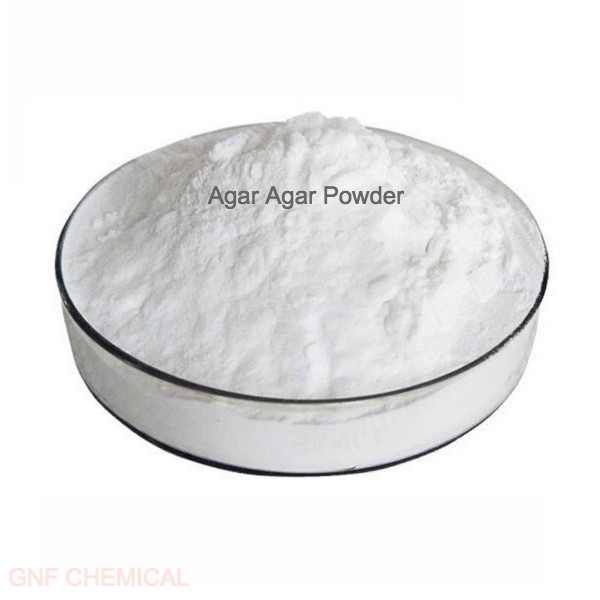
The effects of calcium propionate in the environment are multi-faceted, and are analyzed in the following aspects:
Stability: Calcium propionate is more stable in the environment, which means that its chemical properties are not easy to change under natural environmental conditions, and it can maintain its own structure and properties for a certain period of time.
Degradability: Calcium propionate is not easy to be degraded, it is difficult to be quickly converted into other substances in the natural environment through natural ways such as microbial decomposition, and may exist in the environment for a long time.
Production and use process: In the production and use process of calcium propionate, care needs to be taken to prevent environmental pollution. Although it itself has a low impact on the environment, the production process may produce some waste and wastewater, etc., which, if not handled properly, may have an adverse effect on the surrounding environment. For example, wastewater discharged during the production process may cause damage to water ecosystems if it contains untreated calcium propionate or other chemical substances; during use, if a large amount of calcium propionate enters the soil in an unreasonable manner, it may affect the soil's acidity and alkalinity and the structure of microbial communities, etc.
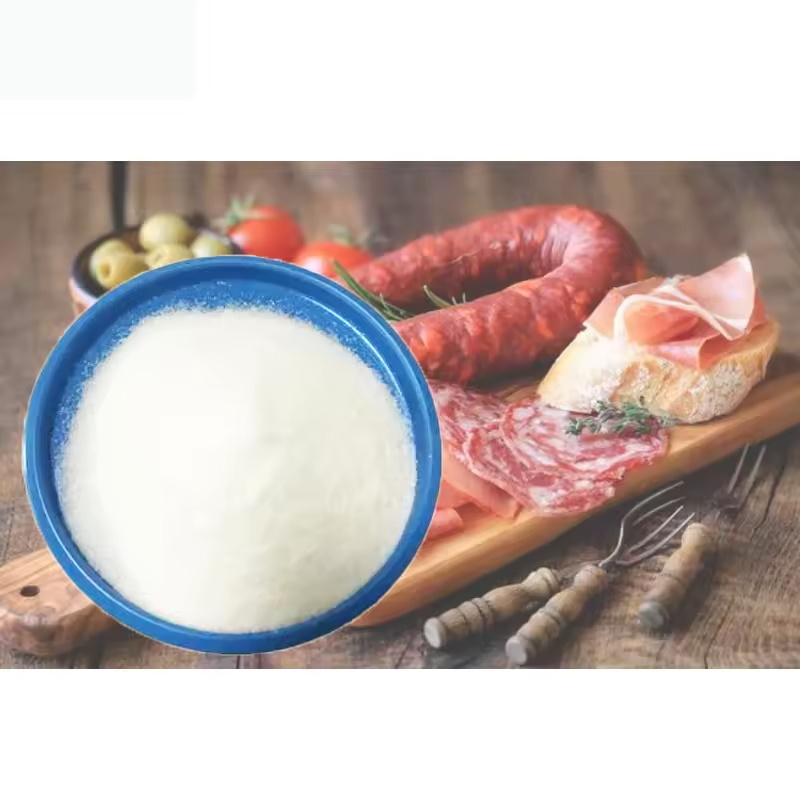
Stevia, also known as stevia glycoside and commonly known as stevia, is a new type of natural sweetener extracted from stevia (or stevia leaf), an herb of the Asteraceae family.123 The following will be a detailed description of its source, composition, properties, characteristics, safety and scope of use in various aspects:
Source and Composition
Plant Source: Stevia is originally from Paraguay and Brazil, and is now cultivated in China, Singapore, Nowadays, it is also grown in China, Singapore, Malaysia and other countries. Stevioside is a kind of glycoside extracted from the leaves of stevia.
Composition: The sweet component consists of stevioside and stevia A glycoside, B glycoside, C glycoside, D glycoside and E glycoside.
Physical and Chemical Properties
Appearance and Status: white to slightly yellow crystalline powder or granule, with cool sweet odor.
Solubility: soluble in water, in the air will quickly absorb moisture, solubility at room temperature more than 40%.
Stability: stable in acid and salt solutions, more stable nature at room temperature. Very stable in pH 3 - 10 range, easy to store. Good solution stability, in the general beverage food pH range, heat treatment is still very stable. In the organic acid containing sucrose solution stored for half a year with little change; in the acid and alkali medium does not decompose, can prevent fermentation, discoloration and precipitation.
Characteristics
High sweetness: the sweetness is 250 - 450 times that of sucrose, but with a slight astringent flavor, stevia A glycoside with obvious bitterness and a certain degree of astringency and menthol flavor, taste characteristics to be worse than stevia disaccharide glycoside A, moderately palatable, the aftertaste of the pure product is less, it is the closest to granulated sugar as a natural sweetener, but the concentration of a high level of off-flavors will have a strange sense. The sweetness of the purified Rebaudioside A sugar is about 450 times sweeter than sucrose, with a better taste.
Low calorie: It is not absorbed after consumption and does not produce calories, so it is a good natural sweetener for diabetes and obesity patients.
Flavor synergy: with citric acid or glycine and good taste; with sucrose, fructose and other sweeteners, taste quality is better. When it is used with citric acid, tartaric acid, amino-acids, etc., it has the effect of killing the aftertaste of steviol glycosides, so it can play the role of correcting the flavor when mixed with the above substances, and improve the quality of the sweet taste of steviol glycosides.
Dissolution characteristics: dissolution temperature and sweetness of the taste of the relationship between the general low-temperature dissolution of high sweetness; high-temperature dissolution after the taste of good but low sweetness.
Safety
The acute toxicity test of Stevia shows that the oral LD50 of stevia crystals in mice is 16g/kg. Preclinical and clinical studies have shown that the use of stevia extract is safe for the general population, including diabetics, children and pregnant women, as well as people with unknown side effects or allergies. It has been consumed by residents of its origin (Paraguay, Brazil and other places in South America) for hundreds of years, and no toxic effects have been found so far.
China's National Standard for Food Safety, Standard for the Use of Food Additives (GB2760 - 2014) clearly stipulates the scope of use and the amount of steviol glycosides.
Scope of use
Food field: it can be used in all kinds of food, such as candy, pastry, beverage, solid beverage, fried small food, seasoning, candied fruit and so on. It can also be used in the production of chewing gum, bubble gum and candies with various flavors; it is used in the manufacture of hard candy together with lactose, maltose syrup, fructose, sorbitol, maltitol and lactone sugar. In addition, it can be used in canned food (canned fruits, aquatic products and canned meat, etc.), pickled products (radish and other pickles, squash), aquatic products (canned fish, kelp, etc.), and meat food (sausage, ham, bacon, etc.), which can play the role of seasoning, antiseptic, prolonging the shelf life, and improving the flavor.
Beverage field: It can be used in soft drinks, orange juice, various fruit juices, ice cream, beer, fruit wine, white wine and other beverages. It can be used in beverages to increase the sweetness, reduce the pungency of wine, and increase the whiteness and durability of beer foam.
Other fields: It can also be used in cigarettes, milk powder and other products, and can also be used as a ripening agent for fruits and vegetables, and used for salt-free storage of foodstuffs.
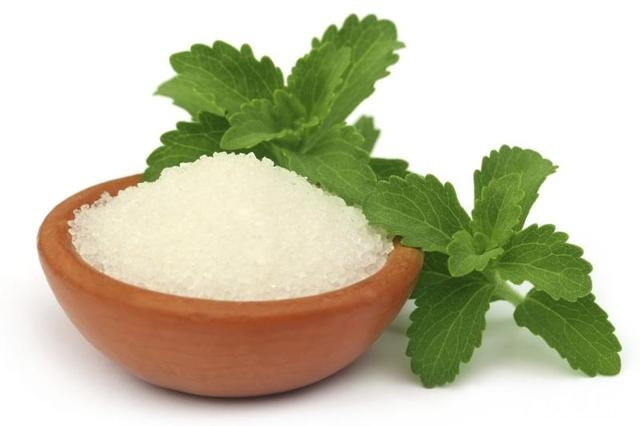
Enhance Your Product Appeal with Customized 18-410 18 mm Aluminum Shell Pipette Dropper
In a world where product differentiation is essential, customization plays a pivotal role in creating a unique identity for your offerings. When it comes to packaging, the 18-410 18 mm Customized Color Aluminum Shell Pipette Dropper stands out as a versatile solution that not only meets functional requirements but also enables you to tailor its appearance to match your brand aesthetics. In this blog post, we'll explore the various customization options available for the aluminum shell, rubber color, and embossed logo, highlighting how they can elevate your product's appeal and make it truly stand out from the competition.
Customizable Aluminum Shell Color:
The cangnuopack 18-410 18 mm Pipette Dropper comes with the advantage of customizable aluminum shell colors. You have the freedom to choose from a range of eye-catching options that include rose gold, glossy gold, matte silver, and glossy silver. By selecting a color that aligns with your brand identity or product theme, you can create a harmonious visual presentation that resonates with your target audience. Whether you aim for a sleek and modern appearance or a luxurious and elegant feel, the customized aluminum shell color lets you achieve the desired effect.


Customizable Rubber Color:
In addition to the aluminum shell color, the 18-410 18 mm Pipette Dropper provides the flexibility to customize the rubber color of the dropper bulb. The range of available options includes vibrant yellow, classic black, and pristine white. The rubber color can be chosen to complement your brand colors, create a strong visual contrast, or convey a specific product attribute. It's an opportunity to infuse your brand personality into the packaging, increasing its visual appeal and making a lasting impression on your customers.


Customized Embossed Logo:
The 18-410 18 mm Pipette Dropper takes personalization to the next level by offering customized embossed logos on the aluminum shell. This feature helps you elevate your brand recognition and create a memorable product identity. By imprinting your logo directly onto the aluminum surface, you provide a premium and professional touch that communicates a sense of quality and craftsmanship. This customization option ensures that your product stands out not only on store shelves but also when it's in use, reinforcing brand awareness and fostering customer loyalty.
Benefits of Customization:
- Brand Differentiation: customization allows you to create a unique packaging design that differentiates your product from competitors, catching the eye of potential customers.
- Brand Consistency: by aligning the aluminum shell and rubber color with your brand palette, you maintain a consistent visual identity across all your products, strengthening brand recognition.
- Enhanced Perceived Value: customization adds a touch of exclusivity and sophistication to your packaging, making it appear more valuable and premium to consumers.
- Memorable User Experience: the embossed logo provides a tactile experience that elevates the perceived quality of your product, leaving a lasting impression on users.


The 18-410 18 mm Customized Color Aluminium Shell Pipette Dropper is a versatile and customizable solution that combines functionality with aesthetics. By offering a wide range of customization options, such as the color of the aluminium shell, rubber, and embossed logo, you can create a unique and attention-grabbing product that reflects your brand identity. Whether you are in the cosmetics, pharmaceutical, or other industries that require precise and controlled dispensing, this custom dropper will meet your needs while adding a touch of elegance. Invest in the 18-410 18 mm Customized Color Aluminium Shell Pipette Dropper and set yourself apart in the market with a personalized and high-quality product.
The 18-410 18 mm Customized Color Aluminium Shell Pipette Dropper can be used for various products that require precise dispensing or sampling. Some common applications include:
- Essential oils: The pipette dropper is useful for dispensing small quantities of essential oils for aromatherapy, skincare products, or DIY projects.
- Cosmetics: It can be used for precise dispensing of serums, facial oils, and other liquid cosmetic products.
- Pharmaceuticals: The dropper is suitable for dispensing medications, tinctures, or liquid supplements in pharmaceutical applications.
- Laboratory and scientific use: It can be used for accurate measurement and dispensing of reagents, chemicals, or samples in a laboratory setting.
- Food and beverage industry: The dropper can be used for dispensing flavorings, food colorings, or liquid additives in the food and beverage industry.
- E-liquids: It can be used for precision filling of e-cigarettes or vaporizers with e-liquid.
- DIY projects and crafts: The dropper is handy for various crafting projects, such as adding small amounts of dyes, inks, or pigments to art materials.
These are just a few examples, and the applicability of the dropper can extend to other industries or products requiring accurate and controlled dispensing of liquids. It's important to ensure that the specific product and its compatibility with the dropper are verified before use.
When it comes to Korean BBQ grills, most people focus on design, heat output, and cooking performance. But there’s one component that is often over looked—and it's more important than you might think: the power cord.
In this article, we’ll explain why choosing the right power cord for your Korean BBQ grill is critical, how it affects safety and performance, and what to look for when evaluating power cords for your restaurant or business.
Why the Power Cord Matters
The power cord is the life line of any electric Korean BBQ grill. It delivers the electricity needed to heat the grill quickly and maintain a consistent temperature. A low-quality or unsuitable power cord can lead to:
-
Overheating
-
Voltage drops
-
Fire hazards
-
Shortened equipment lifespan
In other words, the performance and safety of your grill largely depend on the power cord.
Key Impacts of Power Cord Quality
1.Safety
A poor-quality or under-rated cord can overheat and even melt, posing a serious fire risk. Using a certified, heat-resistant cable with the correct amperage and voltage rating ensures safe operation—even during long hours of use.
2.Stable Performance
An undersized or inferior cord can lead to voltage drops, causing the grill to heat unevenly or fail to reach the desired temperature. This can directly affect cooking quality and customer satisfaction.
3.Durability
High-quality cords are built to withstand the constant plugging, unplugging, bending, and exposure to heat and grease that come with commercial kitchen use. Investing in a durable cord means fewer replacements and less downtime.
4.Compliance
Most countries have strict electrical safety standards. Using certified power cords (e.g. UL, CE, or other local standards) helps ensure your grill setup complies with local regulations—especially important for restaurants undergoing inspections.
What to Look for in a Good Power Cord
When choosing or replacing a power cord for a Korean BBQ grill, consider the following:
-
Voltage and amperage rating: Match the grill’s requirements (e.g., 110V/220V, 10A/15A).
-
Heat resistance: Ensure the insulation can handle high temperatures.
-
Cable thickness: Thicker cables carry current more safely and efficiently.
-
Length: Use the correct length—too short limits flexibility; too long can cause voltage drops.
-
Certifications: Look for marks like UL, CE, or national safety approvals.
Our Commitment to Quality Power Cords
We understand that the power cord is not just a simple accessory—it’s a critical safety and performance component of every Korean BBQ grill we manufacture.
That’s why westrictly use internationally certified power cords, sourced from trusted suppliers and tested to meet global safety standards. All our cables are:
-
UL / CE / CCC certified(depending on customer region)
-
Made withheat-resistant insulation
-
Rated forhigh current and long-term use
-
Built to withstand demanding commercial kitchen environments
You can clearly see the difference in quality from the image below. Our power cords are thicker, better insulated, and securely attached to the grill units to prevent wear and potential hazards.
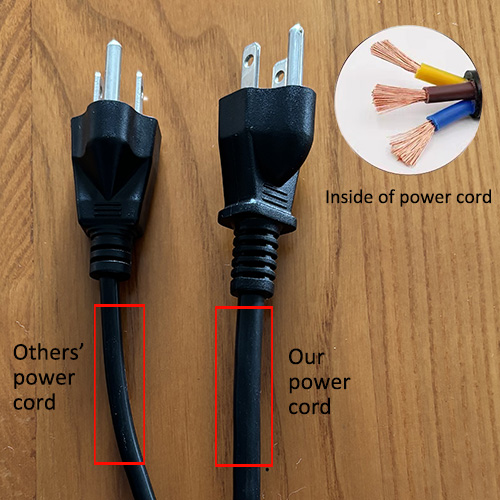
By choosing our grills, you're not only getting powerful performance and sleek design—you’re also gettingpeace of mind, knowing your equipment meets the highest electrical safety standards.
We are an experienced one-stop supplier for hot pot and Korean BBQ equipment.
If you’d like to learn more about our products, feel free to explore our website.
When opening or upgrading a Korean BBQ restaurant, the Korean grill table is one of the most important pieces of equipment. At our company, we supplyhigh-quality Korean BBQ tables that combine great design, durability, and customer-friendly features — trusted by restaurant owners worldwide.
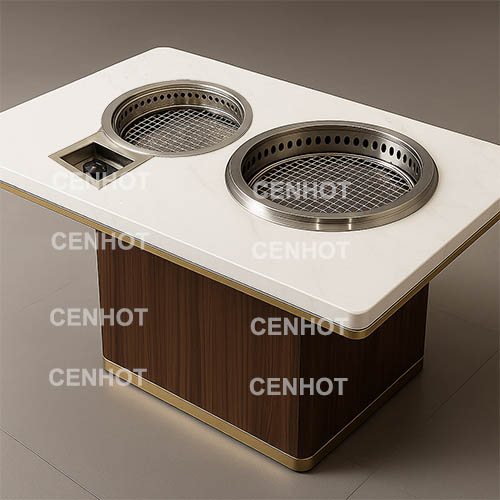
1. A Wide Range of Styles
We offer multiple styles to match your restaurant’s concept:
-
Round grill tables– Great for groups and family-style dining.
-
Square or rectangular tables– Ideal for maximizing space and a modern look.
-
Built-in grill tables– Clean and professional appearance with seamless integration.
-
Movable grill units– Flexible for different setups or seasonal use.
No matter your floor plan or theme, we have a style that fits.
2. Premium Materials: Stainless Steel, Solid Wood & Stone
Our Korean BBQ grill tables are made usingtop-grade materials:
-
Stainless steelfor durability, easy cleaning, and a professional feel
-
Solid woodfor a warm, classic look and strong structure
-
Stone countertops(like granite or quartz) for heat resistance and an upscale finish
These materials are carefully selected to handle the high heat and daily use in busy restaurants.
3. Choose the Grill Type That Works for You
We support all popular BBQ cooking methods:
-
Charcoal grills– Authentic flavor, traditional style
-
Gas grills– Clean, convenient, and easy to control
-
Electric grills– Safe and suitable for indoor use, especially in smoke-controlled environments
Grill units can be built into the table or designed for easy replacement and maintenance.
4.Strong Frame Design with Functional Options
We focus not only on the surface but also on the structure beneath. Our BBQ tables feature:
-
Well-designed frame structurethat ensures long-term stability and strength
-
Options fortable legsortable barrels (drum-style base)
-
Table barrelscan be equipped with built-insmokeless systems, helping to remove oil smoke directly under the table while maintaining a clean, beautiful restaurant environment
Whether you want a modern open-leg design or a closed base that hides the smoke system, we’ve got the right solution.
5. Safety, Comfort, and Clean Air
Our tables are designed with user safety and restaurant air quality in mind:
-
Heat-insulated edgesfor safe, comfortable dining
-
Easy-to-clean surfaces
-
Optional smoke purifiersinstalled under the table barrel — hidden, efficient, and silent
This gives your restaurant a more elegant look without sacrificing function.
6. Trusted Service and Global Shipping
We offer more than just great products:
-
Strict quality control before delivery
-
Fast and secure global shipping
-
Professional support and after-sales service
Many restaurant owners reorder from us thanks to consistent quality and reliable service.
Our Korean BBQ grill tables combine smart structure, strong materials, and flexible design — from open-leg tables to closed barrels with built-in smokeless systems. Whether you're building a new restaurant or upgrading your current space, our tables are a smart, stylish, and durable choice.
Get in touch today for more details or a customized quote.
When purchasing Korean BBQ equipment for a restaurant or retail business, it’s not just about the design or price. Certifications play a crucial role in making sure your equipment is safe, legal, and suitable for your local market.
Whether you’re importing a Korean BBQ grill for your dining tables or installing smokeless BBQ equipment to create a cleaner indoor environment, the right certifications are essential. Here’s what you need to know.
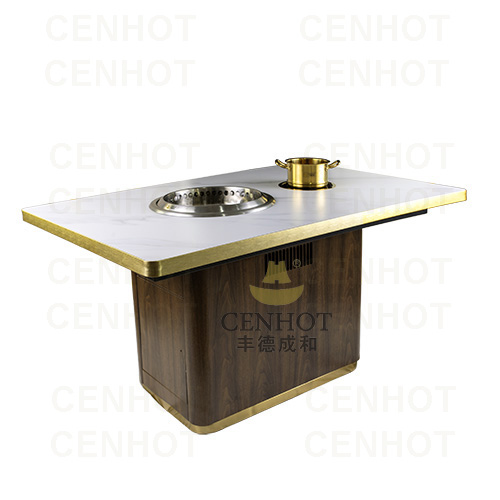
The UL (Underwriters Laboratories) mark is required for electrical and gas-powered cooking equipment in the U.S. Many smokeless BBQ equipment systems and built-in Korean BBQ grills must meet these standards.
Why it matters:
Ensures compliance with local safety codes.
Required by many fire departments and health inspectors.
Common in commercial restaurant kitchens.
2. ETL Certification (North America)
ETL is similar to UL and widely accepted across the U.S. and Canada. It’s often used for electric BBQ grills, exhaust systems, and smokeless BBQ tables.Why it matters:
Accepted alternative to UL.
Covers both gas and electric Korean BBQ grill units.
Helps with insurance and inspection approvals.
3. CE Certification (European Union)
All electrical or gas-operated BBQ grills, including smokeless Korean BBQ grill systems, must carry the CE mark to be legally sold in Europe.Why it matters:
Proves compliance with EU health, safety, and environmental standards.
Important for equipment operating under high heat or power.
Required for importing and customs clearance in EU countries.
4. NSF Certification (Global – Food Safety)
If your BBQ grill comes into direct contact with food, like most Korean BBQ grill tops do, NSF certification ensures it's safe and hygienic.Why it matters:
Commonly required in restaurants in the U.S. and Canada.
Often expected for smokeless BBQ equipment with built-in heating surfaces.
Ensures easy cleaning and prevents contamination.
5. CSA Certification (Canada)
If you’re opening a Korean BBQ restaurant in Canada, look for CSA-cert
We provide high-quality Korean BBQ grills and smokeless BBQ equipment, fully certified for the U.S., EU, Middle East, and other markets. Whether you're opening a new restaurant or upgrading your kitchen, our products help you stay compliant, safe, and stylish.
Mechanism of action and preservative principle
preservatives are a class of additives that can inhibit microbial activity and prevent spoilage of products such as food or cosmetics. They play a crucial role in ensuring food safety and extending the shelf life of products. The following are the main mechanisms of action and principles of preservatives:
1. Interference with the enzyme system of microorganisms
Preservatives can inhibit enzyme activity by interfering with the enzyme system of microorganisms and disrupting their normal metabolic processes. This way of action makes microorganisms unable to grow and reproduce normally. 2.
2. Coagulation and denaturation of microbial proteins
Certain preservatives can coagulate or denature microbial proteins, thereby interfering with their survival and reproduction. This mechanism affects microbial life by altering the structure of proteins, causing them to lose their original function.
3. Altering the permeability of the plasma membrane
Preservatives can also alter the permeability of the plasma membrane of microorganisms, inhibiting the elimination of enzymes and metabolites from their bodies and leading to cell inactivation. By affecting the integrity of the cell membrane, this mode of action prevents the entry of nutrients and the elimination of wastes, ultimately leading to the death of the microorganism.
4. Affecting genetic material or the structure of genetic particles
Some preservatives are able to act on the genetic material or the structure of genetic particles of microorganisms, affecting processes such as replication of the genetic material, transcription and translation of proteins. This mechanism prevents microorganisms from reproducing and growing by interfering with their gene expression.
5. Influence of environmental factors
The action of preservatives is also influenced by environmental factors, such as temperature, pH, osmotic pressure, radiation, hydrostatic pressure, water source, nutrients, oxygen, organic growth factors, etc. These factors can affect the effect of preservatives, for example, under acidic conditions, certain preservatives have a strong inhibitory ability against molds, yeasts and bacteria.
To summarize
Preservatives inhibit the growth and multiplication of microorganisms through a variety of mechanisms, thereby extending the shelf life of products such as food or cosmetics. Understanding these mechanisms of action and principles of preservation helps to select appropriate preservatives to ensure product safety and effectiveness. In practical application, appropriate preservatives should be selected according to the specific use environment and target microorganisms, and used in strict accordance with relevant standards to avoid adverse effects on human health.
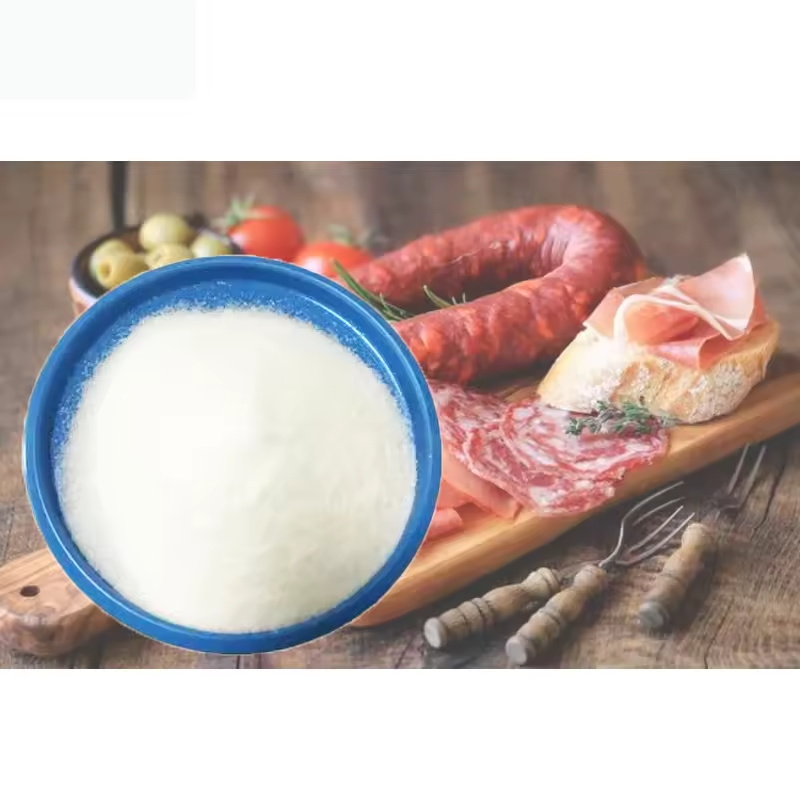
- Buddha Jump Over the Wall1
- Canned Abalone2
- Canned Turtle Soup1
- Edible Bird's Nest2
- Frozen Foods1
- Frozen Seafood8
- Jelly/Pudding Applications1
- Meat Product Applications2
- Others Applications5
- Plant-based meat Product Applications1
- SURIMI2
- Soft Candy1
- Soft Candy Applications4
- bottle1
- can end2
- packaging film2
- tableware3